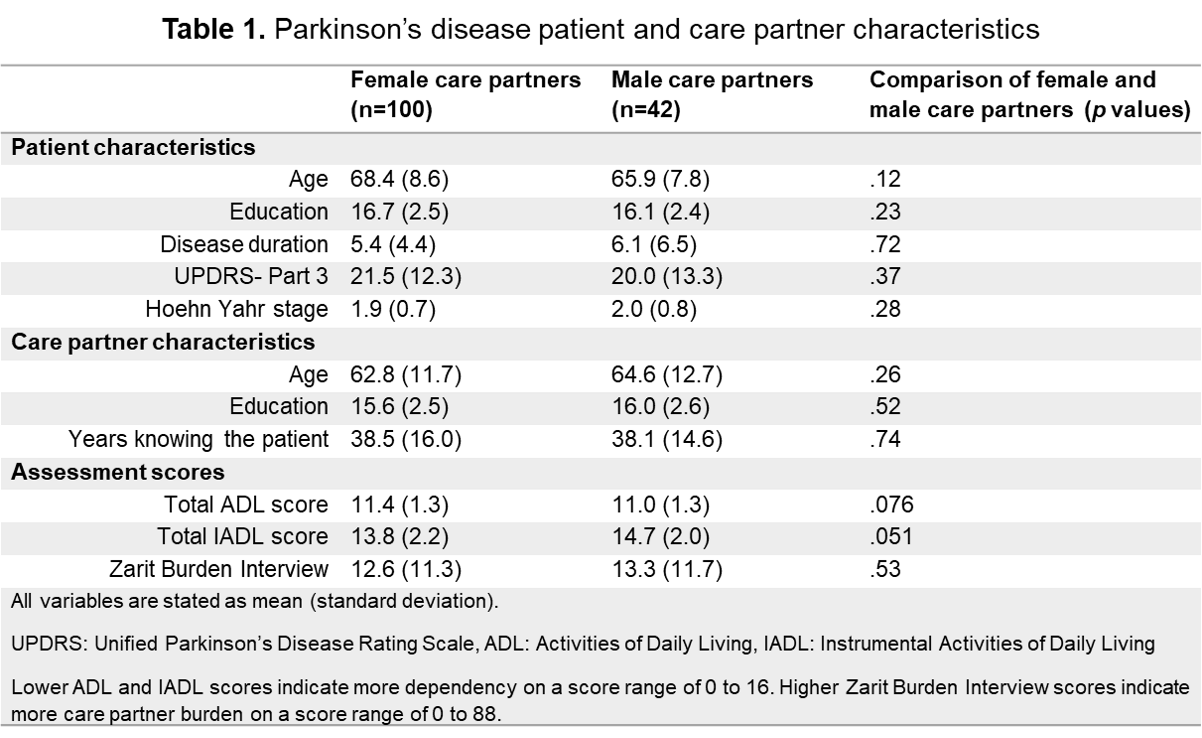Objective: To determine the activities of daily living (ADLs) associated with higher burden for female and male care partners in Parkinson’s disease (PD)
Background: Care partners of PD patients take on many responsibilities to support their loved ones during the course of this progressive disease, which eventually put a strain on their own well-being [1]. Although the association between different PD symptoms and care partner burden have been investigated, determining the specific ADLs (e.g., feeding, dressing) and instrumental ADLs (IADLs; e.g., handling medications, managing finances) associated with burden can help prioritize certain domains to address and guide efforts to develop much needed resources to support patients and care partners. Female care partners may have a higher risk for burden in PD than men [2–5], area of need can differ by sex of the care partners and need to be determined.
Method: Care partners (100 women, 42 men) of non-demented PD patients completed the ADL, IADL scales for dependency levels of their PD patients, and Zarit Burden Interview for care partner burden. Association between care partner burden and individual ADLs/IADLs were determined for female and male care partners.
Results: Male PD patients were more likely to have a female care partner, and female patients were more likely to have a male care partner (p<.001). Otherwise, female and male care partners had similar demographics and were caring for PD patients with similar demographics and disease severity [table1]. Compared to men, female care partners reported that their patients needed more help with preparing food and laundry (p<.005, p<.010). Compared to women, male care partners reported that their patients needed more help with physical ambulation (p=.038). For female care partners, higher burden was associated with their patients needing more help with shopping (B=-11.1, p<.001). For male care partners, higher burden was associated with their patients needing more help with transportation (B=-21.4, p=.001) and toileting (B=-18.2, p<.001).
Conclusion: Different ADLs/IADLs are associated with burden for female and male care partners, suggesting that sex of the care partner needs to be considered to address the need for support in ADLs of PD patients. These ADLs/IADLs (shopping for female care partners, transportation and toileting for male care partners) can be prioritized to reduce care partner burden in PD.
References: 1. Mosley PE, Moodie R, Dissanayaka N. Caregiver Burden in Parkinson Disease: A Critical Review of Recent Literature. Vol. 30, Journal of Geriatric Psychiatry and Neurology. 2017. p. 235–52. 2. Pasetti C, Rossi Ferrario S, Fornara R, Picco D, Foglia C, Galli J. Caregiving and Parkinson’s disease. Neurol Sci. 2003 Oct;24(3):203–4. 3. Calder SA, Ebmeier KP, Stewart L, Crawford JR, Besson JAO. The prediction of stress in carers: The role of behaviour, reported self care and dementia in patients with idiopathic Parkinson’s disease. Int J Geriatr Psychiatry. 1991 Oct;6(10):737–42. 4. Lyons KS, Stewart BJ, Archbold PG, Carter JH. Optimism, pessimism, mutuality, and gender: Predicting 10-year role strain in Parkinson’s disease spouses. Gerontologist. 2009 Jun;49(3):378–87. 5. Henry RS, Lageman SK, Perrin PB. The relationship between Parkinson’s disease symptoms and caregiver quality of life. Rehabil Psychol. 2020 May;65(2):137–44.
To cite this abstract in AMA style:
R. Gandhi, D. Schiehser, N. Whiteley, V. Filoteo, S. Lessig, I. Litvan, E. Bayram. Sex-specific associations between care partner burden and activities of daily living in Parkinson’s disease [abstract]. Mov Disord. 2021; 36 (suppl 1). https://www.mdsabstracts.org/abstract/sex-specific-associations-between-care-partner-burden-and-activities-of-daily-living-in-parkinsons-disease/. Accessed December 18, 2025.« Back to MDS Virtual Congress 2021
MDS Abstracts - https://www.mdsabstracts.org/abstract/sex-specific-associations-between-care-partner-burden-and-activities-of-daily-living-in-parkinsons-disease/

